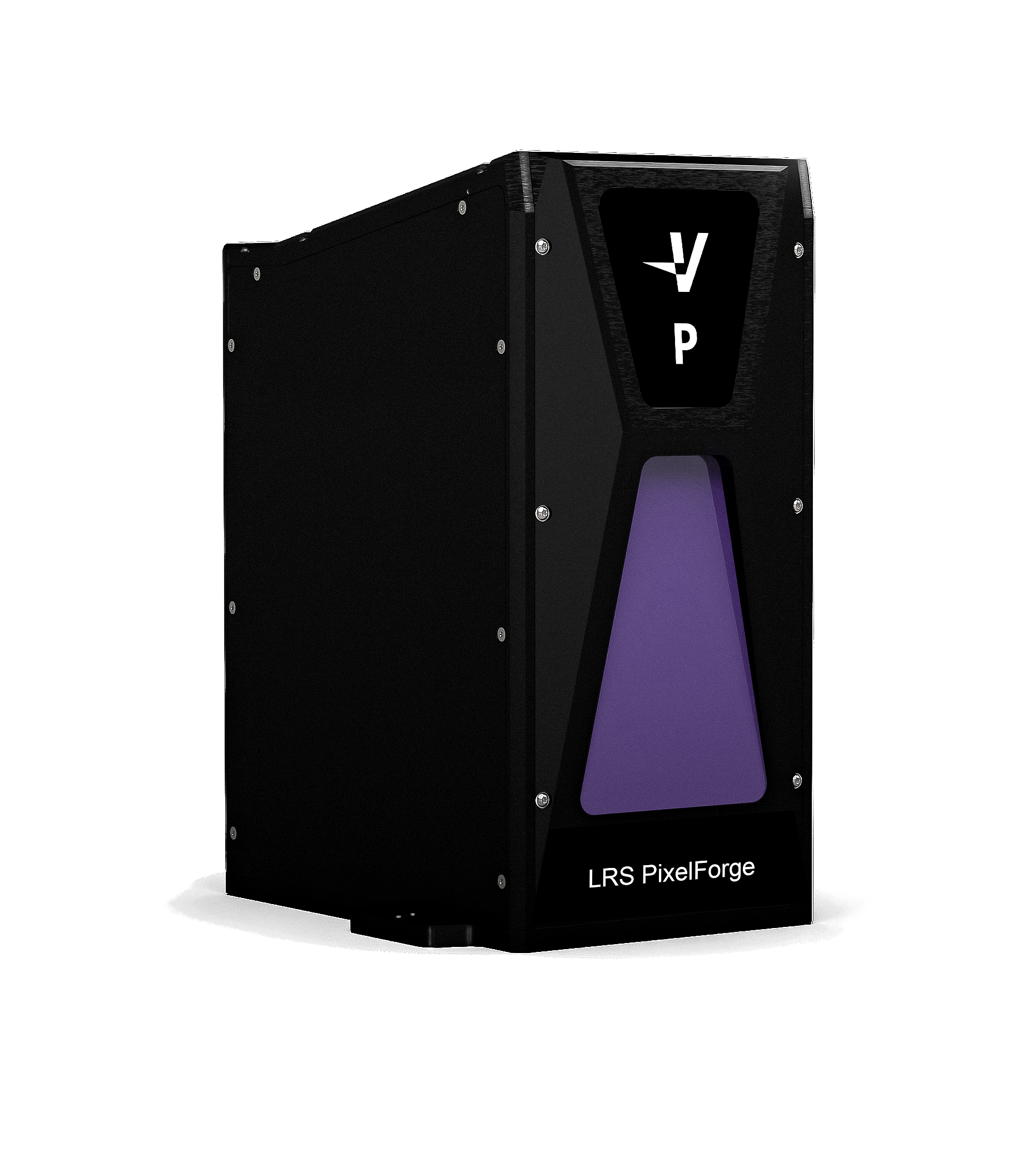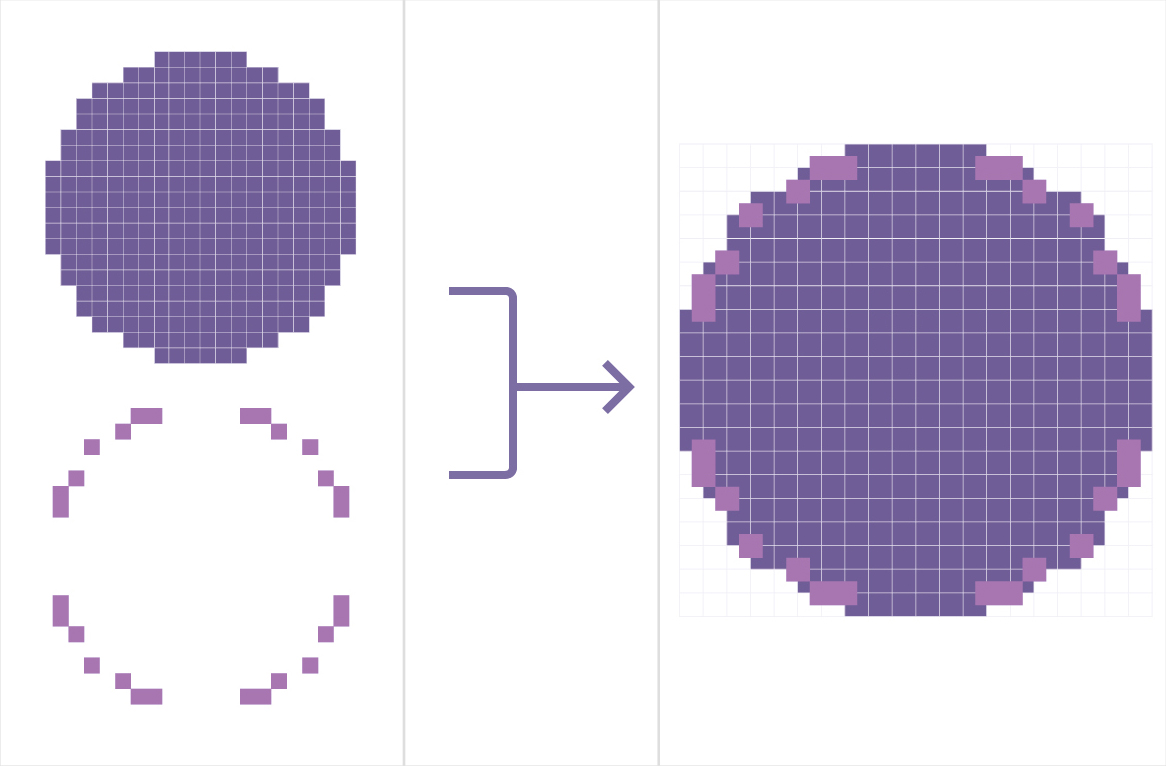Build today.
Scale tomorrow.
The LRS-PixelForge Series gives innovators and developers a professional starting point for developing and refining their additive manufacturing processes. With an industrial-grade interface, liquid cooling, and precision light control, it’s built for those ready to move from concept to implementation — building today what will scale tomorrow.
Recommended use

Building today what will scale tomorrow
LRS-PIXELFORGE
When pixel size and dimensional accuracy of your smaller printed parts matter, the LRS-PixelForge’s high native pixel resolution of 4 million pixels truly shines.
Depending on your wavelength and cost targets, options with 2716 x 1528 or 5433 x 3057 (LRS-PixelForge 5G) resolutions are available. When you need larger build area sizes, the LRS-PixelForge offers stackability from 70 micron pixel pitch upwards. Providing easy and seamless integration with machine control software, the LAMA software eliminates downturns and compromises from USB and video interfacing, such as HDMI or DisplayPort.
Cost-concerned? The LRS-PixelForge is remarkably cost-efficient, with a proprietary LED module and bundled LAMA software that lets you use Visitech’s proprietary FPSC mode to customize power and exposure settings for the four subframes. The LRS-PixelForge is the ultimate development subsystem, paving the way for production systems.
STACKING: Combine the outputs for larger builds
The LRS-PixelForge Series, and particularly the base model light engine, is well-suited for stacking in a static configuration. The 70 micron (and above) native build field pixel pitch ensures that the combined light engines achieve a smooth surface finish, providing a cost-efficient solution to increase your print productivity for large build field areas.
High resolution
With more than 16 million addressable pixel positions, the DLP-based stereolithography subsystem is designed explicitly for static implementations in 3D printing and additive manufacturing systems, producing the highest-resolution parts.
Consistency
Achieving unit-to-unit consistency between light engines can be challenging, especially in cost-conscious market segments. To ensure consistency, the LRS-PixelForge Series features extensive and detailed product characterization and calibration.
LAMA platform benefits
Transfer your work to the next tier-level systems, thanks to LAMA. Being the world’s smallest WQXGA DLP light engine for AM is not the only benefit of the LRS-PixelForge Series. The LAMA software platform, on which it is built, offers several advantages—including the ability to copy scripts and settings to other LAMA-compatible systems. The LRS-PixelForge Series comes with an encapsulated optical core and meets the demands of the additive manufacturing world.
Further cross-platform features include standardization on industrial-grade Ethernet for communication and data transfer, as well as liquid cooling as the preferred thermal control for maximizing power and performance.
Optimal performance
Visitech’s proprietary Bifrost S LED light source features advanced power output control to maintain optimal performance. The LRS-PixelForge Series comes with the AM-optimized and fully integrated LAMA Standard software base.
Full pixel sequence control (FPSC mode) explained (simplified view)
The advanced LB6600 controller of the LRS-PixelForge projector provides complete control of the data content in the projected subframes, yielding valuable advantages:
No re-sampling errors
The controller uses the exact native resolution of the DMD, which allows pixel-pure exposures. This differs from systems using the original DMD reference controller, which was designed for UHD video inputs but requires data re-sampling. Re-sampling causes unwanted pixel errors due to a mismatch between the controller and the DMD.
Complete control of the optical actuator
You can control actuator positions timewise on every layer and apply an image offset of 1/2 pixel to generate a better resolution of outer contours in each layer, resulting in a better surface finish of the printed objects.
Fleixble architecture
Flexible architecture for simple and easy integration with your machine design.


| Properties | ||||
|---|---|---|---|---|
| DMD Type | DLP660TE 0.66” WQXGA | |||
| Resolution | LRS PixelForge: 2716 x 1528 pixels | |||
| LRS PixelForge 5G: 5433 x 3057 pixels | ||||
| Operation Mode | LRS PixelForge: Native pixel mode | |||
| LRS PixelForge 5G: FPSC mode | ||||
| Projector Output Power | Up to 4 W (405 nm) | |||
| LED Options | 460 nm / 405 nm (385 nm upon request) | |||
| LED Driver | Bifrost S | |||
| Constant Flux with Optical Feedback | ||||
| Power Uniformity | > 99% after Software Correction | |||
| Dimensions w/o Lens | 217 mm (H) x 105 mm (W) x 164 mm (L) | |||
| Total weight w/o PSU | 4 kg (w/o lens) | |||
| Power consumption | Max 200 W | |||
| Cooling system | Liquid cooling | |||
| Software | LAMA Standard (included) | |||
| Electrical connections | Signal | |||
|---|---|---|---|---|
| Power supply | 48 V DC | |||
| Image Data | Single Image Pattern Upload with LAMA | |||
| Communication | Ethernet | |||
| LED Safety Switch | LED Safety Switch (enable/disable) | |||
| Frame Sync | External Frame Synchronization | |||
| Lens Options | LRS PixelForge | LRS PixelForge 5K | ||||||||
|---|---|---|---|---|---|---|---|---|---|---|
| Working Distance [mm] | Mounting Distance [mm] | Pixel Pitch in Image [μm] | Native Image Size [mm2] WxH | Pixel Pitch in Image [μm] | Native Image Size [mm2] WxH | |||||
| PL Compact 1.0 HC | 71 | 162 | 5.4 | 14.7 x 8.3 | 2.7 | 14.7 x 8.3 | ||||
| PL Compact 2.0 HC | 90 | 162 | 10.8 | 29.3 x 16.5 | 5.4 | 29.3 x 16.5 | ||||
| PL Compact 3.6 HC | 143 | 149 | 20.0 | 54.3 x 30.6 | 10.0 | 54.3 x 30.6 | ||||
| PL Compact 4.6 HC | 180 | 194 | 25.0 | 67.9 x 38.2 | 12.5 | 67.9 x 38.2 | ||||
| PL Compact 9.3 HC | 216 | 281 | 50.0 | 135.8 x 76.4 | 25.0 | 135.8 x 76.4 | ||||
| PL Compact 13.0 HC | 352 | 415 | 70.0 | 190.1 x 107.0 | 35.0 | 190.1 x 107.2 | ||||
| PL Compact 14.0 HT | 505 | 610 | 75.0 | 203.7 x 114.6 | 37.5 | 203.7 x 114.6 | ||||
| PL Compact 17.0 HT | 532 | 646 | 90.0 | 244.4 x 138.0 | 45.0 | 244.4 x 137.5 | ||||
| PL Compact 24.0 HT | 845 | 955 | 130.0 | 353.1 x 199.0 | 65.0 | 353.1 x 198.6 | ||||
| Other lens options are available upon request. All specifications and features are subject to change. | ||||||||||